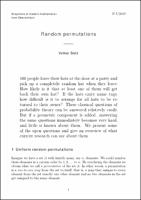| dc.contributor.author | Betz, Volker | |
| dc.contributor.editor | Tokus, Sabiha | |
| dc.contributor.editor | Jahns, Sophia | |
| dc.date.accessioned | 2019-07-12T09:29:51Z | |
| dc.date.available | 2019-07-12T09:29:51Z | |
| dc.date.issued | 2019-07-12 | |
| dc.identifier.uri | http://publications.mfo.de/handle/mfo/2510 | |
| dc.description.abstract | 100 people leave their hats at the door at a party and
pick up a completely random hat when they leave.
How likely is it that at least one of them will get
back their own hat? If the hats carry name tags,
how difficult is it to arrange for all hats to be returned
to their owner? These classical questions of
probability theory can be answered relatively easily.
But if a geometric component is added, answering
the same questions immediately becomes very hard,
and little is known about them. We present some
of the open questions and give an overview of what
current research can say about them. | en_US |
| dc.language.iso | en | en_US |
| dc.publisher | Mathematisches Forschungsinstitut Oberwolfach | en_US |
| dc.relation.ispartofseries | Snapshots of modern mathematics from Oberwolfach;2019,07 | |
| dc.rights | Attribution-ShareAlike 4.0 International | * |
| dc.rights.uri | http://creativecommons.org/licenses/by-sa/4.0/ | * |
| dc.title | Random permutations | en_US |
| dc.type | Article | en_US |
| dc.identifier.doi | 10.14760/SNAP-2019-007-EN | |
| local.series.id | SNAP-2019-007-EN | en_US |
| local.subject.snapshot | Geometry and Topology | en_US |
| local.subject.snapshot | Probability Theory and Statistics | en_US |
| dc.identifier.urn | urn:nbn:de:101:1-2019072412131953752065 | |
| dc.identifier.ppn | 1677285656 | |


